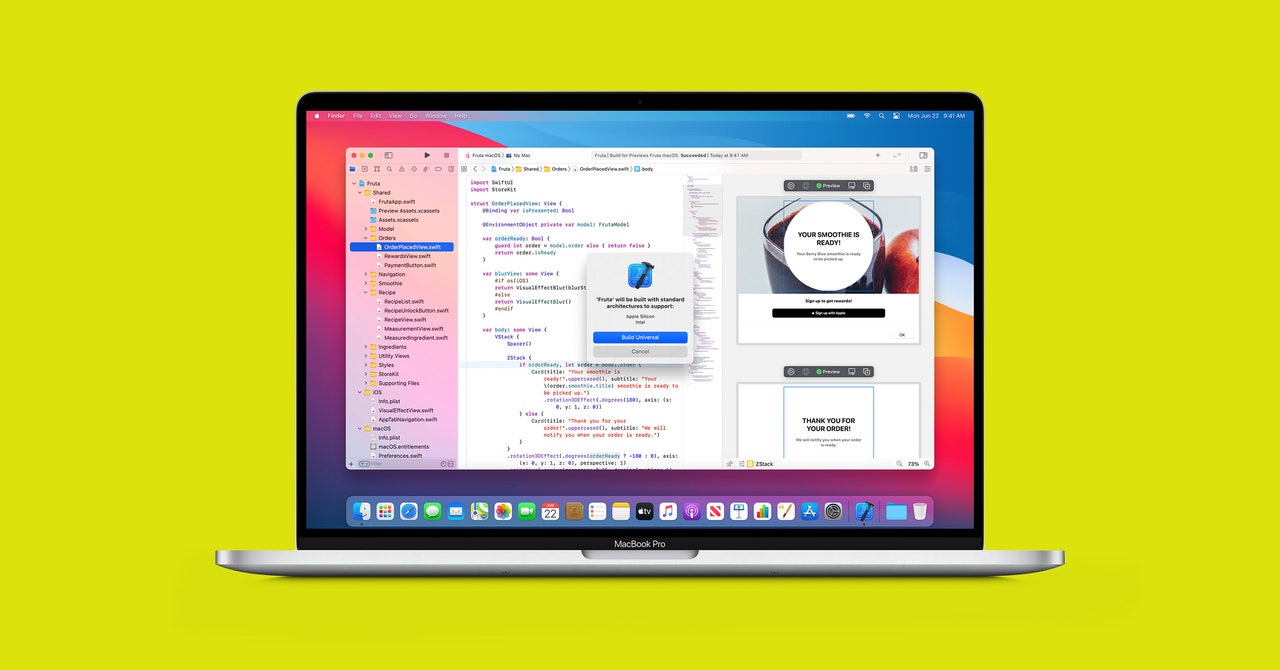As with all demos though, it’s important to keep several grains of salt handy, especially for Apple’s most demanding customers.
“It’s going to be hard for me to imagine a smartphone-based microprocessor replacing a Mac Pro that you just bought for 10 grand,” says Patrick Moorhead, founder of Moor Insights & Strategy. “I wish they would have shown some performance comparisons.”
The A-Series chips in Apple’s iPhone and iPads do hold their own agains their lower-power Intel comparables. But it remains to be seen how quickly Cupertino’s silicon team can level up the chips’ capabilities even further. Based on the company’s transition timeline, the answer seems to be two years or less.
There’s also a question of at what point certain apps, in particular those that aren’t actively maintained, simply stop working on ARM-based Macs. Apple called out that major players like Microsoft and Adobe are already hard at work on the transition, but it seems plausible that certain utilities may get left behind altogether. “I think there will be a culling process like we saw from 32 to 64 bit applications,” says Moorhead. There’s also the question of your existing Mac, and at what point the transition will force you to upgrade. Apple has promised to continue supporting and releasing macOS for Intel-based Macs “for years to come,” with no hard date yet. It’s worth noting, too, that Microsoft and Google have both tried similar convergences across Windows and Chrome, with limited success.
Those potential hiccups seem well worth it for the benefits that Apple will reap. In fact, you don’t even need to look beyond Apple itself for proof that making your own components can provide major advantages.
Apple has used chip designs from ARM as the basis for its iPhone processors since 2010, when it shipped the A4 processor in the iPad and iPhone 4. Since then, the company has been able to develop its mobile hardware and software in concert, finding efficiencies and targeting specific performance gains in a way that competitors have since tried to emulate in increasing numbers. If you control your own silicon, you can also offer features that competitors can’t match, as Apple did with the iPad’s Retina display—powered by the A5x processor—in 2012. In 2017, Apple expanded its solo efforts to making its own GPU, better positioning itself for an augmented-reality future.
The Mac, meanwhile, has been an outlier. Because it relies on Intel’s processors, it can only differentiate features so much. It can’t optimize for power efficiency nearly as well. And it left Apple beholden to an Intel production timeline that has increasingly been beset with delays.
“Ultimately we know that bringing our SoCs to the Mac will allow us to build much better products,” said Apple’s senior vice president of hardware technologies Johny Srouji during Monday’s event. “A key advantage that we have is the tight integration of our silicon with our software.”
These new chips—which will be manufactured by Apple supplier TSMC—will also represent a long-term cost savings to Apple, although how much of that it passes on to customers remains to be seen. (Maybe not worth holding your breath?)
“Apple is a customer across several areas of business, and we will continue to support them,” said Intel in a statement. “Intel remains focused on delivering the most advanced PC experiences and a wide range of technology choices that redefine computing.” (For what it’s worth, Intel makes the bulk of its billions on data center technology and PC chips. Losing Macs won’t upend its apple cart.)
A lot depends on the robustness of Rosetta 2, which remains unknown in practice. Still, the transition seems likely to be relatively seamless for consumers. Apple has every incentive to make this jump, but it’s also given developers every reason to make it with them. “It’s a big ask of developers to support a new chip,” says Maribel Lopez, founder of Lopez Research. “But when they think of it as laying the groundwork for working across multiple devices, it’s an easier sell.”
Which is really what an ARM-based future means for you: A world in which you don’t buy iPhone apps or iPad apps or Mac apps, but just Apple apps that work on whatever device you own.
More Great WIRED Stories
